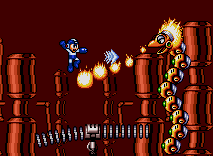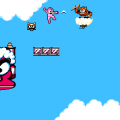- Mega Man (Series Introduction)
- Mega Man
- Mega Man 2
- Mega Man 3
- Mega Man 4
- Mega Man 5
- Mega Man 6
- Mega Man 7
- Mega Man 8
- Mega Man & Bass
- Mega Man 9
- Mega Man 10
- Mega Man 11
- Mega Man: Dr. Wily’s Revenge
- Mega Man II (Game Boy)
- Mega Man III (Game Boy)
- Mega Man IV (Game Boy)
- Mega Man V (Game Boy)
- Mega Man: The Wily Wars
- Mega Man (Game Gear)
- Rockman Complete Works
- Mega Man Anniversary Collection
- Mega Man 3 (DOS)
- Mega Man (DOS)
- Mega Man: Powered Up
- Super Adventure Rockman
- Wily & Right no RockBoard: That’s Paradise
- Mega Man Soccer
- Mega Man: The Power Battle
- Mega Man 2: The Power Fighters
- Rockman: Battle & Fighters
- Mega Man Battle & Chase
- Street Fighter x Mega Man
- Mega Man Tiger LCD Games
- Rockman & Forte (WonderSwan)
- Rockman’s IQ Challenge/Rockman Gold Empire/Rockman Strategy
- Mega Man Mobile Games / Panic Shot! Rockman
- Mega Man Unreleased Games
Seeing the success of Super Mario All-Stars, many companies decided to compile NES classics with updated graphics and sound in hopes to mimic Nintendo’s sales. Outsourced once again to Minakuchi Engineering, each remade title runs off the same engine much like in All-Stars, which like the Mario collection leads to slight differences in comparison to the original 8 bit releases.
Many important character sprites were redrawn, with Mega Man standing taller than usual, though more or less keeping the same hitbox. This leads to some imprecise movement in the game thanks to the repaint not meshing with the intended coding. And that doesn’t even take into account the new bugs. Aside from a random chance for glitched sprites, the major issue is slowdown. Even with the beefier, speedier Motorola 68000 processor, too much motion or sprites onscreen can chug the game down, and many swift enemies are slowed down in the process, like Quick Man and Shadow Man. Controller inputs are delayed as well, making the entire game feel off in general.
The graphics are technically more detailed than before, sporting more colors and shading all around with the Genesis’ expanded palette. The game adds in more touches in the level backgrounds, like distant mountains and support girders in Guts Man’s stage where there was once merely solid blue nothingness, to blinking mechanical blocks buried in the dirt in Wood Man’s stage, to little distortion effects for underwater or heat in Fire Man’s and Bubble Man’s stages.
Unfortunately, many of the redesigns take away some of the original’s charm or clash with the sprite details that can hide enemies in the less contrasting backgrounds. For example, Top Man’s glass lush leafy walls are now drab metallic blocks and Bomb Man’s added chain link fences scour the levels, masking the bottomless pits and dark enemies hiding within them. The music has been upgraded to FM synth by Kinuyo Yamashita, though the compositions aren’t necessarily represented any better for it.
In addition to the updated versions of the first three NES games, the developers added a brand-new miniature game with three new Robot Masters and a four-stage Wily Tower to battle through.
MWN-001 Buster Rod G
Based on Sun Wukong from Journey to the West, he’s the leader of the Genesis Unit. He attacks and defends with his extending pole and can create after-images of himself. He escapes his first battle and reappears in Wily’s Tower.
MWN-002 Mega Water S
The amphibious brains of the G Unit, based on Sha Wujing and the Japanese mythical reptilian demon kappa. He fires off harpoons and protects himself with a water shield.
MWN-003 Hyper Storm H
A big hulking boar bot based on Zhu Bajie. His powerful breath either pulls Mega Man towards him or away into the spiny walls lining his lair. Mets also fall down whenever his hops his heavy frame around. He has the distinction for being the only Robot Master with a double health bar.
With all three games running on the same engine, these new stages cull almost every enemy from the trio of titles, mixing them together like a dream team of baddies to test out all the weapons on. The weapon selection menu before each level allows to choose eight Robot Master special weapons and three utility items from all three games. Obviously, certain weapons and items are more useful than others – why choose Mega Man 2‘s Item-2 when you can have the superior Rush Jet from Mega Man 3? Also, the breakable barrier walls are only susceptible to their respective weapon, so it’s not possible to break a Hard Knuckle wall with Crash Bombs. While Mega Man doesn’t earn any powers from the new bosses of the Genesis Unit, it’s still a nice little sampler. The ending leaves a lot to be desired, having Mega Man chase Wily on foot while the credits roll, but the bonus levels and their music are underground gems that each feel like a fully fledged Game Boy-style retake of content.
The Wily Wars never saw a cartridge release in North America, and only a limited production run in Europe. The PAL version suffers from a bad conversion to 50Hz, making the game run even slower than ever. A translated release was available in the US, but only through Sega Channel.
In 2012, The Wily Wars was one of the games built in along with multiple other Genesis titles in AtGames’s Genesis: Ultimate Portable Game Player. However, due to the bad emulation on AtGames’ devices, this method of playing the game is far from ideal. Intrepid hackers and coders found that overclocking the Genesis/Mega Drive’s CPU or running an overclock-set emulator fixes all the slowdown issues from the dodgy programming, a rare oddity.
Comparison Screenshots


